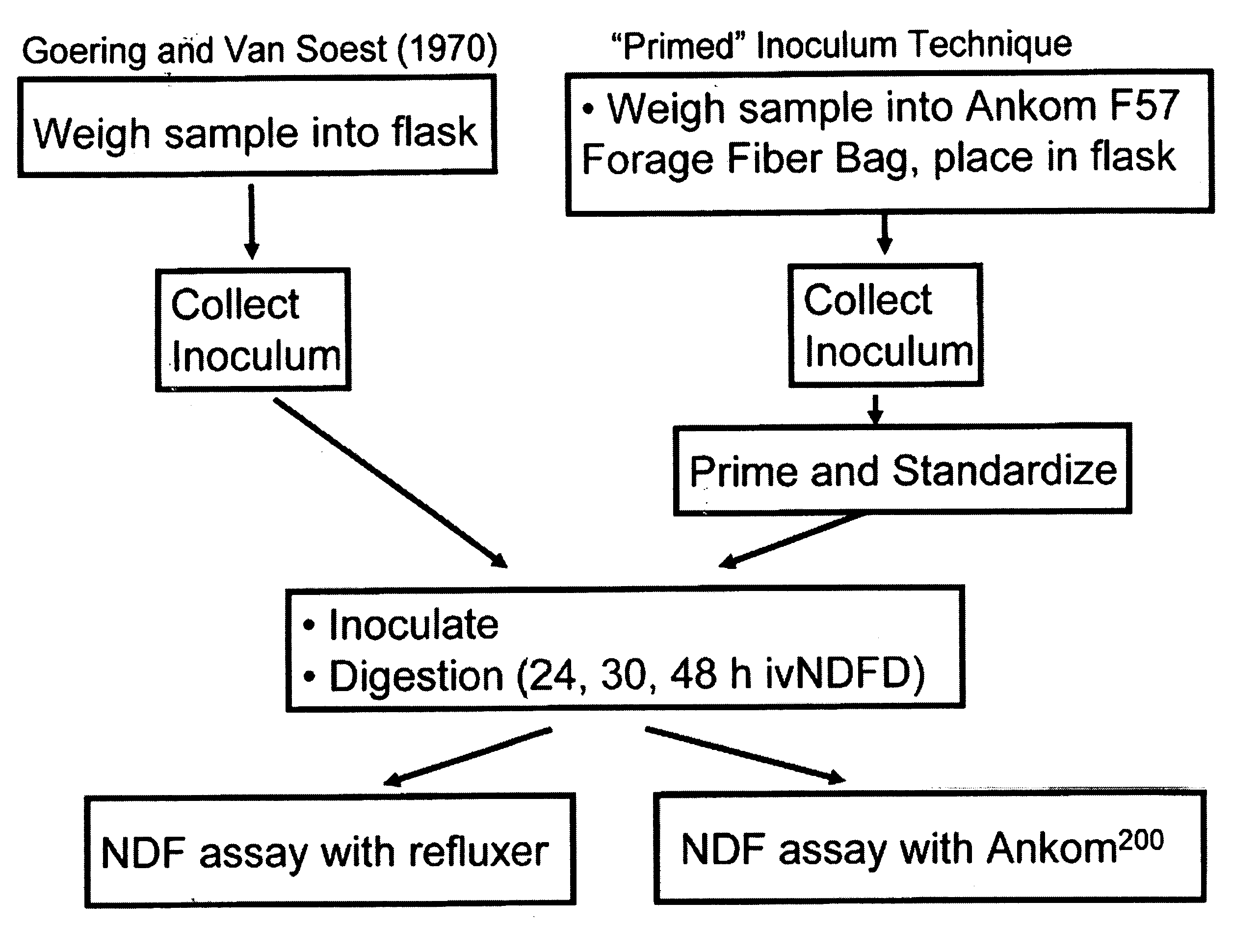Method for measuring fiber digestibility
a technology of digestibility and fiber, applied in the direction of optical radiation measurement, instruments, spectrometry/spectrophotometry/monochromators, etc., can solve the problems of inability to accurately predict the energy content of single forage within the database, yield is imprecise, and the equation cannot accurately predict the energy content of any single forag
- Summary
- Abstract
- Description
- Claims
- Application Information
AI Technical Summary
Benefits of technology
Problems solved by technology
Method used
Image
Examples
example 1
[0105]Standard Protocol:
[0106]This example presents the basic materials, methods, and calculations to carry out an exemplary preferred version of the present invention. The starting time given (3:00 pm) is for convenience only and is provided solely to illustrate how best to coordinate the timing of the various steps of the process.
[0107]Materials Needed:
[0108]Solutions Equipment:
[0109](2) 18 L carboys for macro-mineral and buffer
[0110](1) 250 ml flask for micro-mineral
[0111](1) 125 ml flask for resazurin indicator
[0112](1) 1 L flask for 1N NaOH
[0114]Two shaking water baths set to 39° C., with lids, racks / clamps to secure flasks
[0115]Two CO2 tanks with appropriate glass gas manifolds, one in warm room and one with water baths
[0116]Timesheets / water bath maps (to describe where flasks are located)
[0117]Approximately (250) 125 ml Erlenmeyer flasks
[0118]#5 rubber stoppers (2-hole) w / glass tubes for connecting to rubber hose to connect to gas manifold and rubb...
example 2
[0183]In this Example, an in vitro reference technique was to calibrate the NIRS instrument using a sample set consisting of 122 ground forage samples collected from commercial nutritionists and the University of Wisconsin-Marshfield Soils & Forage Laboratory Marshfield, Wis.). Each forage sample was digested in three separate repetitions, for 24, 30, and 48 h with duplicate sub-samples for each repetition and time point combination. Eighteen forages were analyzed in each repetition, with an alfalfa silage internal standard included in each repetition.
[0184]The Research Animal and Resource Center of the College of Agriculture and Life Sciences, University of Wisconsin-Madison approved the experimental protocol. Approximately 0.5 g of each dried, ground forage sample was weighed into tared, labeled filter bags (F57, Ankom Technology, Macedon, N.Y.), which then were heat-sealed. The bags remained sealed for the entire procedure.
[0185]Two solutions, A and B, were created. Solution A co...
example 3
[0203]The objective of this Example was to determine if a rumen fluid priming technique would improve ivNDFD precision relative to a modified Goering and Van Soest (1970) technique by reducing repetition variance.
[0204]In Experiment A, a rumen fluid inoculum priming technique was compared to a modified Goering and Van Soest (1970) ivNDFD technique and both techniques used rumen fluid inoculum from a single lactating cow. In Experiment B, the rumen fluid priming technique used in Experiment A was compared to a rumen fluid priming technique and a modified Goering and Van Soest (1970) ivNDFD technique that both used inoculum collected and pooled from two lactating dairy cows.
[0205]Two experiments (A and B) were completed comparing 24-hour in vitro NDF digestibilities obtained using modified Goering and Van Soest (1970) techniques and rumen fluid priming techniques in a randomized complete block design. An alfalfa silage sample was dried at 60° C. for 48 h, ground to pass a 1-mm Wiley m...
PUM
 Login to View More
Login to View More Abstract
Description
Claims
Application Information
 Login to View More
Login to View More - R&D
- Intellectual Property
- Life Sciences
- Materials
- Tech Scout
- Unparalleled Data Quality
- Higher Quality Content
- 60% Fewer Hallucinations
Browse by: Latest US Patents, China's latest patents, Technical Efficacy Thesaurus, Application Domain, Technology Topic, Popular Technical Reports.
© 2025 PatSnap. All rights reserved.Legal|Privacy policy|Modern Slavery Act Transparency Statement|Sitemap|About US| Contact US: help@patsnap.com



